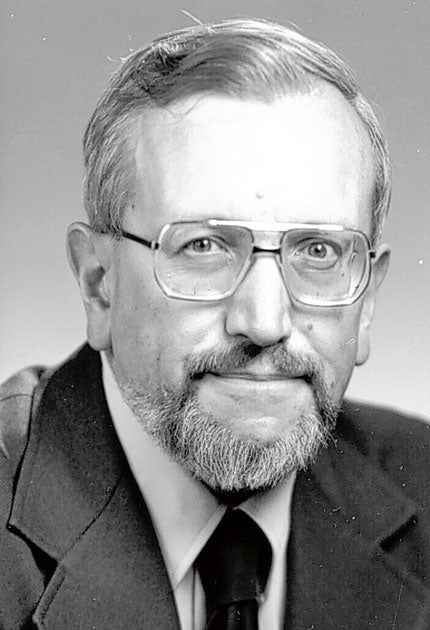Professor John Hardy: Physicist celebrated for his work in the field of lattice dynamics

Your support helps us to tell the story
From reproductive rights to climate change to Big Tech, The Independent is on the ground when the story is developing. Whether it's investigating the financials of Elon Musk's pro-Trump PAC or producing our latest documentary, 'The A Word', which shines a light on the American women fighting for reproductive rights, we know how important it is to parse out the facts from the messaging.
At such a critical moment in US history, we need reporters on the ground. Your donation allows us to keep sending journalists to speak to both sides of the story.
The Independent is trusted by Americans across the entire political spectrum. And unlike many other quality news outlets, we choose not to lock Americans out of our reporting and analysis with paywalls. We believe quality journalism should be available to everyone, paid for by those who can afford it.
Your support makes all the difference.The physicist John Hardy was an international authority in the field of lattice dynamics – the vibrations of atoms within crystals – and was responsible for the development of the famous Deformation Dipole Model for calculating the vibrational properties of insulators. He started his career in England, but moved to the University of Nebraska in 1966, and spent the rest of his life there, becoming Professor Emeritus on his retirement in 2003.
John Hardy was born in 1935 in Hertfordshire to Marjorie and Cyril Hardy, formerly of Derby. His father worked as a telecommunications engineer for British Railways, and both grandfathers and a great-grandfather were employed by the railways, which influenced his passion for model trains. After attending Watford Grammar School, he received his BSc degree in 1956 and his PhD in 1959, both from Bristol University.
After holding positions as a Research Fellow at Reading University and Senior Scientific Officer at the UK Atomic Energy Research Establishment at Harwell, Hardy was invited to the US as a visiting faculty member in the Department of Physics and Astronomy at the University of Nebraska during 1966-67. He was promoted to the rank of Professor of Physics with tenure in 1968 and he remained with the department until his retirement.
His Deformation Dipole Model, developed in the UK, was widely used in calculations of the properties of both pure materials and materials containing defects, and he worked extensively on the theory of shock propagation of condensed matter.
He had an outstanding record of training graduate and postdoctoral students and collaborating with other scientists. His PhD students went on to have distinguished careers in theoretical condensed matter physics at other academic institutions, in industry, and at national laboratories. He was also noted for his highly effective collaboration with experimentalists, maintaining a long-term joint research programme with Frank G Ullman in the study of ferroelectric materials. In 1979 Hardy wrote a book with Arnold M Karo, The Lattice Dynamics of Alkali Halide Crystals, the result of 20 years' study. He served as a consultant to the Lawrence Livermore National Laboratory in California and the US Naval Research Laboratory, Washington DC. His research was supported by the US Army Research Office and the Office of Naval Research. He was a Fellow of the American Physical Society.
In 1982 he received the University of Nebraska Chapter of Sigma Xi's Distinguished Scientist Award and in 1989 the University of Nebraska Award for Outstanding Research and Creative Activity (Orca). He was cited for his pioneering work on the lattice dynamics and statics of crystalline materials, his development of the Deformation Dipole Model, his extensive work on the theory of shock propagation in solids, and identification of the possible origins of high temperature superconductivity. The Orca award is the highest accolade the University can bestow in recognition of a faculty member's research. To honour Hardy for his various accomplishments, the University of Nebraska named him George Holmes Professor of Physics in 1993.
John Hardy was a kind and caring person who dedicated his life to mentoring his students and postdoctoral fellows and to working with his experimental and theoretical colleagues. Those who knew him always enjoyed his dry sense of humour, which replaced his normal shyness after a few beers, and he would have been surprised by the strength of feeling of affection and loss expressed by friends and colleagues after his death. He is survived by his sister Jane, who lives in Norfolk.
John Richard Hardy, physicist: born Watford 9 January 1935; Associated Electrical Industries Research Fellow, University of Reading 1959-62; United Kingdom Atomic Energy Research Establishment, Research Fellow 1962-65, Senior Scientific Officer and Research Fellow 1965-66; University of Nebraska, Visiting Associate Professor of Physics 1966-67, Associate Professor of Physics 1967-68, Professor of Physics 1968-2003, Professor Emeritus of Physics and George Holmes Distinguished Professor Emeritus 2003-11; died Lincoln, Nebraska 5 May 2011.
Join our commenting forum
Join thought-provoking conversations, follow other Independent readers and see their replies
Comments